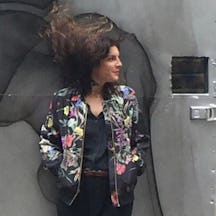In 1817, a pioneering operation performed perfectly came too late to save a dangerously ill man. But it paved the way for life-saving aortic aneurysm procedures – which remain a technical challenge to this day.
The blight of the ballooning blood vessels
Words by Thomas Morrisartwork by Emily Evansaverage reading time 7 minutes
- Serial

One day in March 1816 Charles Hutson, a 37-year-old porter from London, slipped and fell heavily against a wooden chest. His left thigh was badly bruised and he was in so much pain that his workmates had to carry him home. The following morning his upper leg had turned an angry purple, and severe swelling prevented him from getting out of bed. It was three weeks before he was able to return to work, and although his thigh was no longer swollen, Charles found that he could not move his left leg with as much freedom as before.
During the next twelve months his discomfort grew worse, and he started to notice an unpleasant tingling sensation in his leg. It became increasingly difficult for him to perform his duties carrying boxes and parcels, and eventually he was forced to give up his job.

The aorta is the largest artery in the body and damage to it can be life-threatening.
On April 9 1817 Charles was admitted to Guy’s Hospital, a short distance south of London Bridge. He was in great pain, and a strange pulsating mass covered the left side of his groin. This, the doctors quickly realised, was an aneurysm. The accident a year earlier had injured a major artery in Charles’s upper thigh: the weakened vessel had ballooned outwards, forming a large sac full of blood.
Over the next few days the aneurysm doubled in size – a worrying development, since there was a significant chance that it would eventually burst. If that happened, there was little anybody could do to prevent Charles from bleeding to death.
The conventional treatment for such a large aneurysm was bed rest and repeated bleeding. In some cases the blood would simply clot inside the sac, preventing it from growing any further. Rather than attempt a dangerous operation, most doctors preferred to do nothing, hoping that ‘Nature’s cure’ – as they called the clotting process – would save the patient.
The surgeons’ interventions
As Charles lay in his hospital bed, however, the swelling continued to grow. Six weeks after his admission the surgeons attempted to reduce it by compression with a pillow, but their efforts were in vain. Charles’s condition continued to deteriorate, and on 25 June the aneurysm suddenly burst. He would surely have bled to death had it not been for the quick thinking of a young surgical apprentice, Charles Aston Key, who happened to be passing his bed at the time.
Key managed to stop the bleeding by pressing a surgical dressing against the wound. It was evident that Charles’s life was in imminent danger unless the surgeons could attempt some more radical treatment.
At nine o’clock that evening the hospital’s chief surgeon Astley Cooper came to examine him, and found him “in so reduced a state that he could not survive another haemorrhage, with which he was every moment threatened”. Cooper was a strikingly handsome man, and wore his hair powdered and pulled into a tight ponytail known as a ‘queue’. Charles could not have been in better hands, since Cooper was also the most celebrated surgeon in London – and the richest. At this period of his career he was earning well over £20,000 a year, close to £3 million today.

Cooper was considered a very handsome man, as one might guess from the numerous portraits in our collection.
Astley Cooper’s medical interests were wide-ranging, and he published important books on the treatment of fractures, on hernias and on diseases of the breast. But he also had a particular interest in surgery of the blood vessels, and had learned to treat aneurysms using a method pioneered 30 years earlier by another great London surgeon, John Hunter.
Hunter’s technique involved isolating the aneurysm by tying cotton ligatures around the artery. This would cut off the blood supply to the sac to stop it growing any further, while any blood remaining inside it would soon clot and be reabsorbed by the body. This worked well for the smaller arteries of the limbs, but Cooper knew that to treat Charles he would have to tie a ligature around his aorta – the largest blood vessel in his body.
Nobody had ever attempted such a thing, and Cooper thought long and hard before going ahead. He explained the situation to Charles, who replied, “I place my life in your hands, Mr Cooper. Anything you wish I will submit to.”
It was an amazing feat of dexterity: Cooper had managed to tie a loop of tape around the aorta without once laying eyes on it.
The patient was too sick to be moved to the operating theatre, so the surgery took place at his bedside, by the flickering light of an oil lamp. Cooper began by giving the patient a dose of opium – the only pain relief he would receive during a highly invasive procedure. After making an incision in Charles’s abdomen, the surgeon inserted a finger between his intestines and all the way back to his spine.
He turned to his colleagues and said, “Gentlemen, I have the pleasure of informing you that the aorta is now hooked on my finger.” He then used his fingernail to make some space behind it, and then managed to pass a length of cotton ligature around the vessel.
After feeding the ends of the ligature back out through the abdominal organs, being careful not to catch any folds of intestine as he did so, the surgeon could tie it closed. The ends of the cotton were left hanging out of the wound to enable further tightening if required. It was an amazing feat of dexterity: Cooper had managed to tie a loop of tape around the aorta without once laying eyes on it.

This illustration of a burst aneurysm was done from a Victorian post mortem. It shows the damage caused when the aorta ruptures.
Lessons from a tragedy
The initial signs were promising. After a large dose of morphine Charles said that he was “quite comfortable”, and the following day when Cooper went to see him he found his patient smiling and adjusting his own bedclothes. But that evening he took a turn for the worse. He was restless and could not eat or drink; he became progressively weaker overnight, and not long after midday the next day he died.
There’s an old medical joke that “the operation was a success, but the patient died”. The target of this black humour is the surgeon, whose historical stereotype was a person more fixated on technical perfection than the wellbeing of their patient. Astley Cooper cannot be accused of such heartless behaviour, since he was deeply affected by Charles Hutson’s illness and death. But the saying is still apt, since a post-mortem revealed that Cooper had performed a flawless operation; alas, the patient’s disease was just too advanced for it to have helped him. If Hutson had undergone surgery a little earlier he might even have survived.
Despite its tragic outcome, Astley Cooper’s remarkable operation was a landmark in the history of vascular surgery – the first time that anybody had attempted to operate on the largest artery in the body. To put his effort into perspective, it was not until 1923, and with the benefit of anaesthetics and modern infection control, that a surgeon succeeded in saving a patient’s life using the same approach.
Today, despite all the vast improvements in equipment and technique over the last hundred years, operating on the aorta remains one of the most difficult and hazardous tasks a surgeon can undertake. It was Astley Cooper who first showed that it might be possible.
About the contributors
Thomas Morris
Thomas Morris is author of ‘The Matter of the Heart’ and more recently ‘The Mystery of the Exploding Teeth and Other Curiosities from the History of Medicine’. He has worked as a radio producer for the BBC on such programmes as ‘Front Row’, ‘Open Book’ and Melvyn Bragg’s ‘In Our Time’, and his journalism has appeared in publications including the Lancet and the Times.
Emily Evans
Emily Evans is a medical illustrator and anatomist. After her role as a senior demonstrator of anatomy at Cambridge University, alongside her career illustrating medical and surgical books for over a decade, she now writes and publishes books about anatomy and art, such as ‘Anatomy in Black’, while running her brand, Anatomy Boutique.

